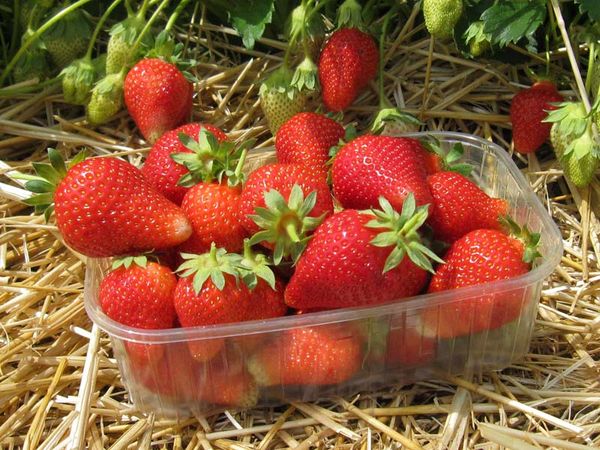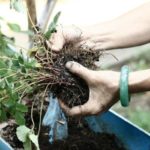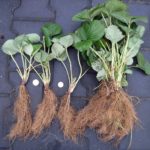All varieties of strawberries can be divided into two classes: for their own consumption and for industrial breeding. The first are appreciated for their high taste characteristics, and the second for their good form and high keeping quality and transportability. Alba combines the qualities of both classes, but the responses about the taste are ambiguous.
Table of contents
Origin of the variety
Albu was taken out by the employees of the Italian company New Fruts,the task of which was to create a high-yielding variety not only with high yields, transportability and keeping quality, but also good taste and presentation.
Alba or hybrid NF311 appeared in the seventies. Parents were made by varieties: albion and cal. 97.85-6. Sort took from parents the best features: high yield, taste and quality of berries. Strawberries quickly took a leading position in the Italian industrial production.
Characteristic strawberry alba
Albu is cultivated both in open ground and in film tunnels, where the crop ripens two weeks earlier. In open ground strawberries ripen by mid-may. In both cases, the variety produces a harmonious harvest, which is important for industrial production.
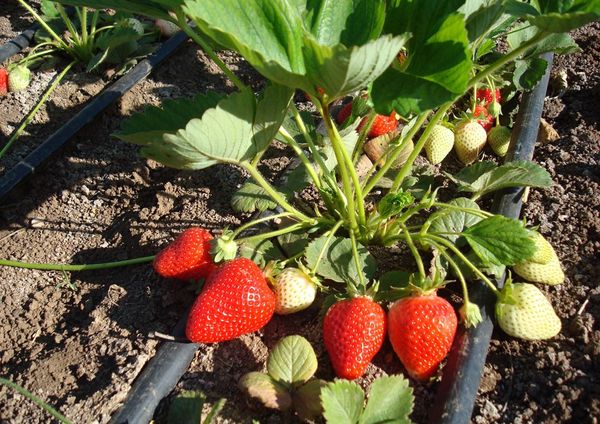
The berries according to the description have an elongated-conical shape, and their weight varies within 25-30 grams. Red fruits have a dense flesh and sweet taste with a slight sourness. It has a long fruiting period and throughout the entire period the berry does not shrink.
Albian bushes have a powerful structure, have low roots and can grow up to 35 cm. One bush can be collected about one kilogram of berries.
This variety is resistant to powdery mildew, verticellezu and fusarium wilt, but may suffer from brown and white spot. Alba is resistant to spring frosts and summer drought.
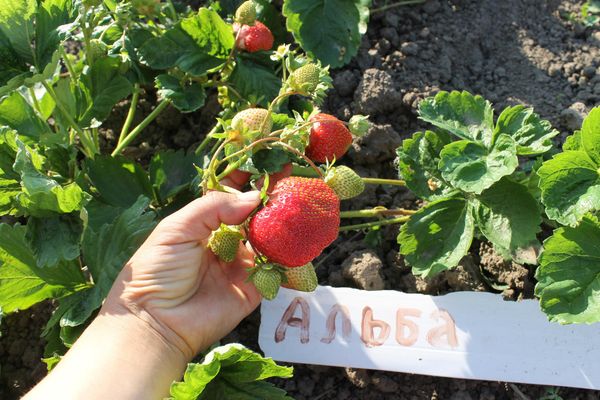
The advantages of the variety include:
- early ripening;
- a good flowering period, which allows you to avoid return frosts;
- rapid formation of berries;
- no tendency to shallow fruit;
- the possibility of mechanized cleaning;
- high rates of transportability and keeping quality;
- marketable condition;
- good and stable yield;
- disease resistance and pests;
- good frost resistance.
The main disadvantages include the duration of the rest period, as well as susceptibility to anthracnose.
Alba refers to drought resistant varietiestherefore needs watering once a week. Other varieties need to be watered every three or four days.
Cultivation
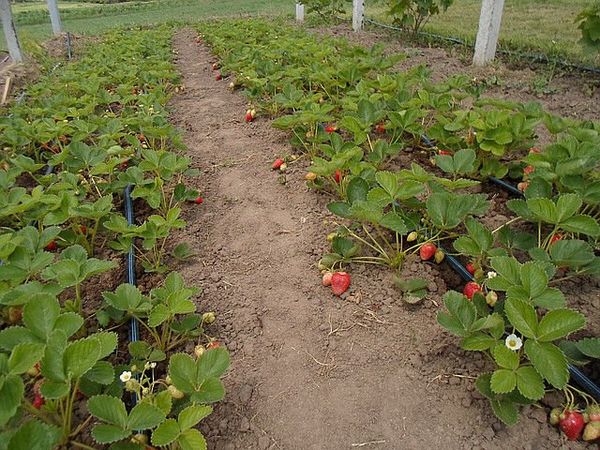
Strawberries should be planted in open, lighted areas, protected from cold winds. It is better that the site previously carried out planting of cereals, garlic, onions or flowering plants - marigolds and petunias.
But after tomatoes, potatoes, eggplants, pepper and raspberry alba to plant undesirable. Such precursors increase the risk of late blight. A strawberry plantation planted after cucumbers and cabbage may be affected by a nematode.
Alba grows poorly at the landing site of corn and sunflower, because they excessively deplete the soil.
Planting strawberries can be carried out in the spring and autumn. Alba, planted in the fall, will give the first harvest in the spring, and in the bushes of spring plantings, berries will appear only in a year. Summer strawberries are also allowed, but the weather should not be too hot.
Soil preparation
Strawberries grow well on sandy or loamy soils enriched with a sufficient amount of organic matter.
Soil preparation for planting is carried out no less than two weeks before the event and includes several stages:
- deep digging;
- removal of weeds and its roots;
- making a starting set of fertilizers.
For each square meter, 10 liters of rotted manure or humus should be applied with the addition of complex fertilizers. The latter can be replaced with ash or superphosphate.
With a close location of groundwater or the tendency of the site to bog, for planting strawberries recommend forming high ridges. This will help prevent root decay and watery berries.
Planting alba on a flat plot helps to retain maximum moisture in the dry season.
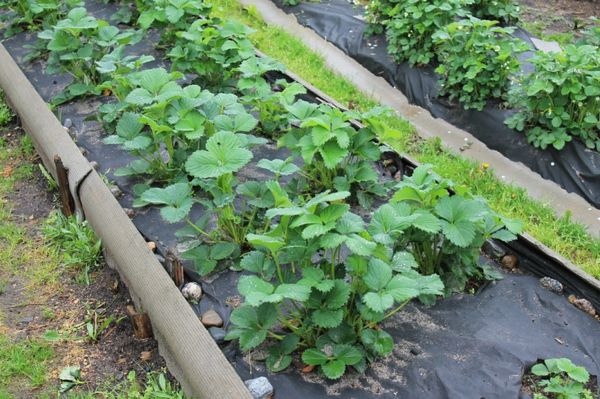
Planting rules for seedlings
String method Planting strawberries is the most common. It is carried out in two lines, the interval between which must be at least 40 cm. The bushes of the alba are planted at a distance of 25 cm from each other, observing a certain technology.
- Prepare planting holes deep 20-25 cm.
- Add humus, ashes and complex mineral fertilizers to each well.
- Spill the wells with water.
- Seedlings must be obtained from antennae not older than one year.
- The roots of planting material are placed in a growth stimulator solution and kept in a shaded place for six hours.
- Healthy seedlings are planted vertically so that the core is located at ground level and the roots are completely covered with soil.
Every bush after planting you need to waterto compact the soil. Subsequent watering is carried out as needed. Do not over-wet or dry out planting - this leads to the development of fungal and infectious diseases.
Competent care
Caring for the alba in the first year after planting is aimed at building up a strong root system, therefore new tendrils and peduncles need to be removed.
Care for more adult plantings depends on the season.
- After wintering. In early spring, the winter shelter is removed, the damaged leaves are removed, and the soil is loosened. Mineral or organic fertilizers should be applied three times a month.Procedures carried out before the first berries. From mid-spring, regular watering should be carried out, starting with small portions, but twice a day.
- Before flowering. During this period, the beds should be mulched in order to prevent the growth of weeds, to ensure clean planting and to protect the berries from rotting. Strawberries are poured over with a solution of urea or ash infusion. If desired, spray solutions to stimulate yields.
- In the flowering period. During this period, strawberries need potassium supplements, humus and ash. To increase the number of ovaries, it is necessary to spray with boric acid, a teaspoon of which is diluted in ten liters of water. Young antennae at this time should be cut so as not to lose part of the crop.
- In a month after the start of fruiting. They carry out preventive pruning of new antennae, which makes it possible to prolong the yield, prevent the berries from diminishing, reduce the risks of morbidity, and also facilitate the harvesting of fruits.
- Wintering. After the end of fruiting, remove all damaged parts of plants, weed grass and cover the strawberries with a special material or hodge.This will ensure good survival in the winter and accelerate the growing season.
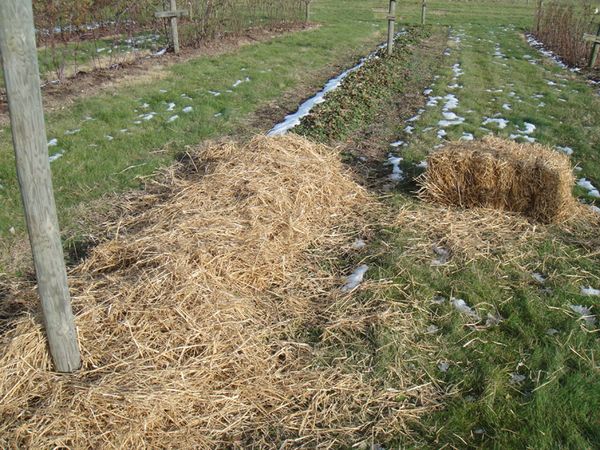
To improve the taste characteristics of alba, fertilization is recommended with the content of not only macro, but also microelements.
Experienced Gardeners do not recommend growing an alba in one place for more than three years. After this period, the amount of harvest is reduced, and the berry loses its characteristics.
Therefore, you should take care of transplanting strawberries to a new place. But it will be possible to plant the former site only in four years.
Breeding methods
For the propagation of the alba, the method of dividing the bush, rooting of the antennae (rosettes) is used, less often resort to the seed method.
The method of dividing the bush
Is carried out according to a specific scheme:
- the procedure is performed in the spring, after establishing a stable positive temperature or after harvesting;
- select two or three-year healthy shrubs with stable fruiting;
- bushes carefully removed from the ground without damaging the roots;
- root system is divided in two or three parts sharpened sterile instrument. On each fragment there should be a rosette with leaves;
- the slices are treated with manganese solution.
Each fragment is planted in prepared landing holes.
- The bush is dug along with the earthy ball
- And divided into 2-3 parts with a sharp knife
Antennal rooting
Harvesting planting material is carried out in late June, following standard rules.
- Prepare the soil mixture by mixing equal parts of peat and garden soil. The mixture is fertilized with humus. You can also use ready-made soil for strawberries.
- Antennae are planted in individual containers filled with soil mixture, and placed in a warm, well-lit room.
- It is necessary to ensure that the soil is constantly moistened.
- Planting can be fertilized with extract of mullein or yeast.
- When three pairs of leaves form on the rosettes, remove the remaining antennae and transplant the plants to a permanent place.
When transplanting should be maintained earthen room, which will prevent damage to the roots and speed up the rooting process in a new place.
Seed method
Therefore, this method is rarely used, and the seeds should be purchased in nurseries.But you can try to get them yourself.
The procedure includes several steps:
- large ripe fruits are selected, from which the upper third is cut, kneaded and laid out in the sun;
- dried raw materials should be soaked in water and select the seeds;
- collected seeds soaked for 2-3 days in a weak solution of manganese or growth stimulant;
- prepared seed is sown in planting tanks filled with special soil, and placed in a warm, lit place;
- after the appearance first real leaf seedlings swoop down.
Planting of young plants in open ground should be carried out in the spring, after a preliminary hardening bushes. The procedure is that taking out strawberries to fresh air, gradually increasing the time for “walking”.
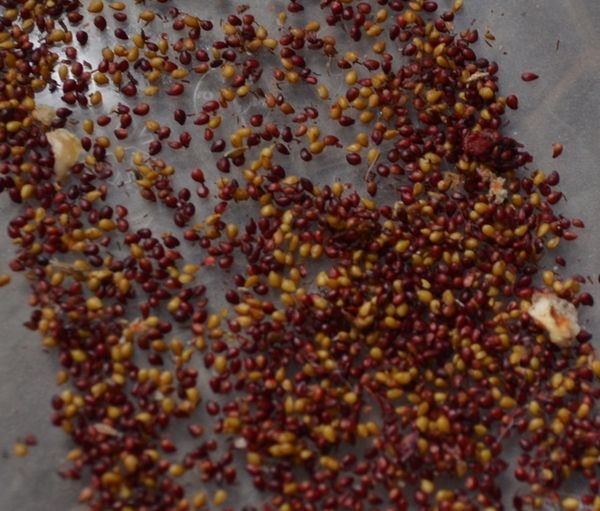
Diseases and pests
Strawberry alba is immune to many fungal diseases, but is often affected. anthracnose. The cause of the development of the disease is increased humidity. The signs of the disease appear as small maroon spots on the leaf plates, which gradually increase in size. If nothing is done, the plantation may die.
When the first signs of illness appear, strawberry plants are treated with special preparations. When the disease is neglected, it is necessary to destroy all the bushes, and to treat the soil with Bordeaux liquid.
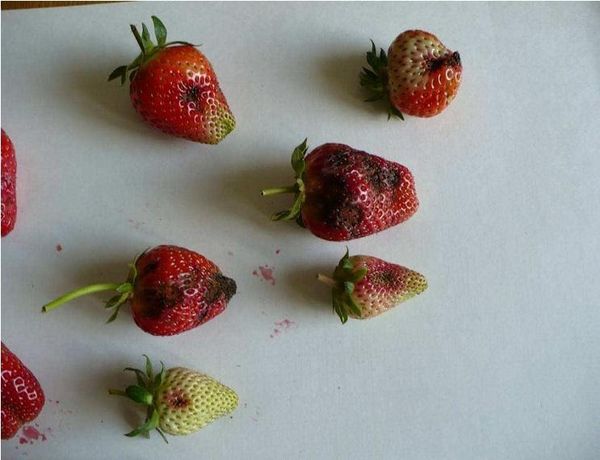
Of the pests on strawberries often attacks aphids and weevils, to combat which resorted to spraying soapy water or special preparations.
The taste of Alba strawberry disappointed many summer residents. It does not differ strong sweet and pronounced aroma. But the variety has gained popularity among farmers who grow berries for sale.
Good keeping quality and spectacular appearance endow the Album with high purchasing power. Also, this strawberry is versatile to use, so it can often be found on home gardens.
